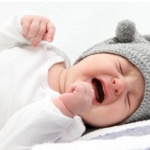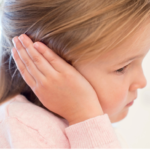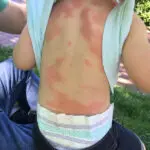Hot babies! How to manage fevers in children.

No More Worries
A Blog by Hope Chest Pediatrics
Kelly Cotaleen Todd CPNP-AC/PC FPA
Fevers! Every parent’s biggest reason for visits and calls to medical providers. In this blog post, I will try to dispel any myths, misinformation, and misguidance. As with any blog, this is intended as information, and not a replacement for your own medical providers assessment. Always use your best judgement, and seek advice, or an in- person assessment when needed.
Let’s get started with some basics on why fevers show up in the body. I always try to reassure my patients and their caregivers that fevers are not harmful, in and of themselves. Typically, fevers are the body’s way of turning up the heat to fight off an invader. Invaders can be viral or bacterial in nature, in other words an infection. Think about boiling water or bottles to kill germs, a fever is essentially doing that for your body. Healthy brains are very smart, and have natural top off points; contrary to popular belief there is no “dangerous” number on a thermometer reading. Young children have higher metabolisms, therefore they also have higher heart rates and breathing rates than adults at baseline, meaning not sick. When a temperature goes up, heart rate and breathing rate follow. Which is why you will see your child’s breathing and heart quicken when they are very hot. One flows to the other, so the body can compensate , seeking the natural equilibrium that the body craves.
What about febrile seizures (fever seizures), you ask? These are actually not as common as you might think, and only occur in about 2-5% of children, ages 5 years and younger with fevers (1). There is no way to prevent them from happening, because every child is different, with different thresholds (boiling points). Some children may have fever seizures with fairly low fevers, others can be very high, and some are set off by the rate of how quickly the temperature rises.
Evaluate
Now that we have the nitty-gritty on fevers, let’s get into the down and dirty of how to treat the child who has a fever; what symptoms to track, and when to seek care. Earlier, we discussed that fevers are not dangerous . If your child is not super fussy, is playful, and drinking well even if they have a fever of 105F then just keep on keeping on my friend. Keep a log of their temperatures throughout the day and other symptoms as well.
Tools
My favorite thermometers are the good old under-the-armpit or “axillary” ones. No need to add a degree or two or whatever that ancient practice was, it is what it is.
Medication Options
You can safely give any Acetaminophen product per box or your providers direction on dose over 3 months of age every 4-6 hours. Acetaminophen can technically be given after birth; however, if your baby is 30 days or younger and has a fever of 100.4F or more, different steps are required as they are not treated the same as older infants and children. Call your provider AND take them to your closest pediatric equipped emergency department for further evaluation. The doctor may need to see your child in-person, do blood work, etc. because fever in that age group can be variable and quite serious.
Ages 31 days to 12-weeks is provider and illness dependent, which is why I would encourage touching base with your provider prior to treating the child in order to get their guidance. Ibuprofen products can be given over 6 months of age every 6-8 hours. This one is my preferences because it works on inflammation (think teething/earaches), as well as fever and lasts longer so it’s great for bedtime.
If your child is miserable and the fever is going up and down, you can alternate Acetaminophen and Ibuprofen every 3-4 hours. Reserve this for very miserable babies that are only drinking with one on board and WRITE IT DOWN! Keep a log of time, temperature and what medication you gave the child so that you don’t get confused and give two doses of the same back-to-back . Only alternate for a couple days before seeking an evaluation by a provider.
Non-Medication Options
An all-natural, safe alternative for children 6 months and older is Arnica tabs, which can be given per box directions. Please treat this in the same category as Ibuprofen and avoid using both during an illness or minimally 6 hours apart. Cool, tepid baths are also a non-medication option for bringing temp down and comfort. Dress them in light clothing and no hats because they trap heat in…let them breathe! Fevers tend to follow a pattern where they spike at night so be proactive and ensure that the child has a lightweight blanket and clothes, as well as a cool room to sleep.
Additionally, it’s so important to maintain the child’s hydration because overall fluid requirements increase with fevers the body is expelling fluids. We want you to encourage the child to drink more fluids, which means every 20 minutes offer ½-1 oz. for children under 12 months. This should be whatever milk your baby is drinking (breast/formula.) From 6 months of age through 11 months, you can also offer popsicles and Pedialyte if they are having borderline wet diapers. Borderline means that at a minimum, a child should have a wet diaper every 8 hours. Another way to assess hydration, is to observe them when they are crying. If they are hydrated, there will be tears and their mouth will be wet as well. I do not recommend offering straight juice when a child is under 12 months old. Children who are over 12 months, I recommend only 6 oz at most because more would cause diarrhea and contribute to dehydration.
No Worries takeaways :
- Fever is not harmful no matter the number
- Treat with medications for comfort, so your child is comfortable enough to drink and stay hydrated
- Fever in a newborn 30 days and younger means call your provider AND go to the nearest pediatric equipped emergency department for further evaluation, not an urgent care.
- Fever in ages 31 days-12 weeks means call your provider and listen to their guidance on next steps.
- Ibuprofen and Arnica products are for 6 months and over and no more than every 6 hours.
- WRITE IT DOWN: keep track of the number the temperature gets to and what med you gave at what time.
- Touch base with your provider after 2-3 days of fevers for evaluation and wait no more than 5 days of straight fever to be evaluated




